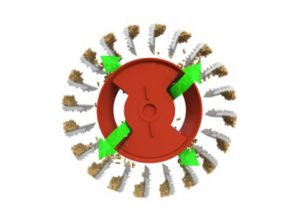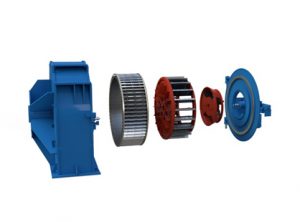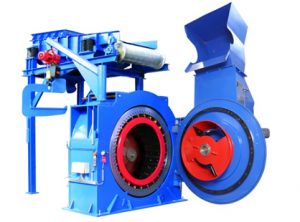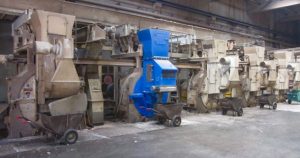
Innovation for optimizing flake preparation for particleboard production.
Over the last years, the strategic collaboration between Dieffenbacher-group and INSERCO resulted in an intensive development of Dieffenbacher- and Maier presence in Latin-America, followed by many sales to this important region. Today we wish to present latest news about a quality and cost optimization for MDP flake manufacturing.
 Flake quality is crucially important for cost-effective particleboard production. It has a significant impact on downstream production steps such as drying, screening, sifting, gluing, and pressing. Moreover, it affects the final mechanical board properties and the finishing and further processing of raw boards.
Flake quality is crucially important for cost-effective particleboard production. It has a significant impact on downstream production steps such as drying, screening, sifting, gluing, and pressing. Moreover, it affects the final mechanical board properties and the finishing and further processing of raw boards.
Optimum flake quality enables the saving of raw materials and glue required for particleboard production. The key requirement of flake preparation is achieving an optimum – preferably constant – sieve distribution curve and receiving flat flakes with narrow thickness tolerance, adapted to the needed board quality.
Modern particleboard plants mostly use knife ring flakers for the flake preparation. In practice, these machines may have difficulties achieving uniform material distribution in the flaking chamber. This situation can be significantly improved using the FlowOptimizer.
All knife ring flakers currently on the market have a similar general design and working principle.
The wood chips are fed into the flaker via a vibration conveyor with magnetic drum and material cleaning system, executed as an air sifter. The air flow used for the sifting process axially forwards the chips through an opening in the machine door into the flaking chamber. In the flaking chamber the chips axially impact the rotor, are deflected in the radial direction, and are guided by the rotor shovels to the knives of the knife ring to be cut into the required flat flakes.
Crucial factors affecting flake quality include the quality of the wood chips, the adjusted knife ring protrusion, the knife angle and knife relief angle, the gap between the rotor knives and knife ring, and the size of the flake discharge gap, determined in the modern knife rings by the wear plates. The uneven wear of the parts interacting with the material flow at the rotor and knife ring not only reduces the life of the parts themselves, but it also results in difficulties adjusting knife protrusion, rapid worsening of the cutting conditions, and finally, loss of flake quality.
A well-known problem is that the material being deflected by the rotor in the radial direction often impacts the knives of the knife ring only at a relatively limited zone. In this zone, the wear of knives and wear plates is faster than in the zones with less material load. As a result, the entire knife length (knife ring width) cannot always be used evenly.
Another problem of modern flakers is that the feeding via an axial air flow and gravity force – combined with particular flaking chamber design – make it impossible to distribute material over the knife ring circumference homogeneously.
As a result, the knife ring has a limited zone with maximum material load, depending on the direction of the rotor rotation.
 A new approach from Maier, however, does solve the problem. Using “3-D distribution technology”, it ensures the optimum material distribution over both the entire knife ring width (knife length) and the entire knife ring circumference.
A new approach from Maier, however, does solve the problem. Using “3-D distribution technology”, it ensures the optimum material distribution over both the entire knife ring width (knife length) and the entire knife ring circumference.
The key is the FlowOptimizer, a special distribution rotor integrated into the flaking chamber. The axially blown-in chips enter the inner chambers of the distribution rotor, are set into rotation and are guided via centrifugal forces through the openings at the front and rear side of the system toward the main rotor. This achieves optimum distribution over both the knife ring width and the entire knife ring circumference, allowing the optimum and uniform use of the entire knife length.
The primary advantages of optimum 3-D material distribution are optimization of flake quality and lower operating costs per ton of material produced.
Overall, the new solution provides thefollowing:
• Optimum use of the total knife length (both of the complete width, as well as the entire circumference of the knife ring), resulting in increased throughput and extending the service life of wear parts;
• Uniform wear on all wear parts of the rotor and knife ring affected by material flow. This enables optimized adjustment of the knife ring to improve flake quality;
• Smaller rework and regrinding, e.g., of the rotor blades and the knives of the knife ring;
• Optimum cutting conditions over a greater period of time, thus reducing energy consumption during the flaking
process.
 The new FlowOptimizer is mounted with bearings in the flaker door, making the retrofitting of existing machines very simple: Only the door with the distribution rotor and heavy particle separator must be replaced. The ability to easily retrofit flakers on the market was another important target of the new development.
The new FlowOptimizer is mounted with bearings in the flaker door, making the retrofitting of existing machines very simple: Only the door with the distribution rotor and heavy particle separator must be replaced. The ability to easily retrofit flakers on the market was another important target of the new development.
The FlowOptimizer is available as an upgrade for existing flaker systems (not only Maier) and as a standard component for the latest generation of new Maier MRZ knife ring flakers.
 So far more than 30 units have been ordered by clients all around the world. Many of them as consecutive orders to equip all flakers in the plant with this new technology.
So far more than 30 units have been ordered by clients all around the world. Many of them as consecutive orders to equip all flakers in the plant with this new technology.
INSERCO is can supply you with additional technical information and test results of running machines. We are at your disposal to answer your questions and prepare a budget quotation.








